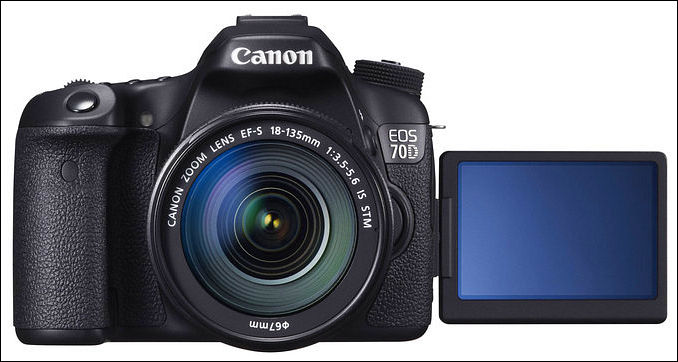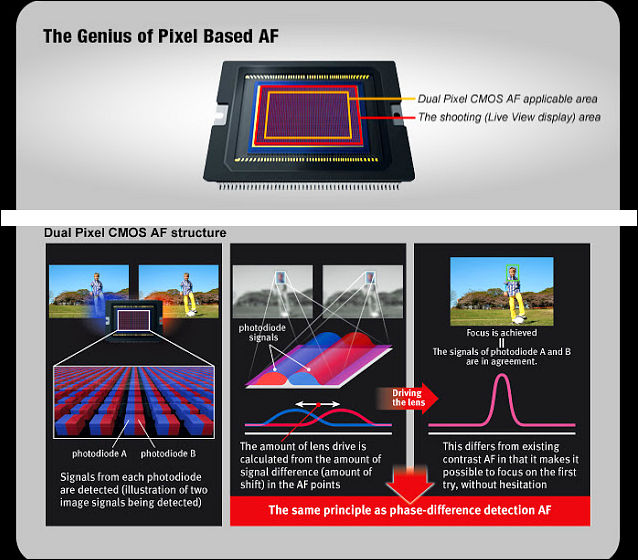
It allows to keep PV going, with more focus towards AI, but keeping be one of the few truly independent places.
-

Specs
- 20.2Mp APS-C sensor
- DIGIC 5+ LSI
- ISO 100-12800
- 7fps
- Silent shutter mode
- Video - 1080p ALL-I or IPB 30p/25p/24p
- and 720p ALL-Ior IPB 60p/50p,
- External mic socket
- 19-point AF system, all points cross-type, sensitive to -0.5 EV
- 63-zone iFCL metering system
- 98% viewfinder coverage, 0.95x magnification, switchable gridlines and electronic level display
- Articulated 1040k 3" LCD
- SDHC card slot
- Wi-Fi
- Single-axis electronic level (sic!)
- AF microadjustment (ouch :-) )
- In-camera HDR
- Sealed body
- Weight - 755g
- Dimensions - 139x104 x79mm
- Price - $1200 for body, $1350 for kit.
Hand ons and previews
- http://www.popphoto.com/gear/2013/07/canon-70d-dslr-dual-pixel-cmos-af-first-impressions
- http://www.dpreview.com/previews/canon-eos-70d
- http://www.dslrmagazine.com/digital/camaras-reflex-monoculares-digitales/canon-eos-70d-nueva-etapa-en-sensores.html
- http://www.thephoblographer.com/2013/07/02/first-impressions-canon-70d/
- http://www.theverge.com/2013/7/2/4484098/canon-eos-70d-dslr-announced-new-filmmaking-autofocus-dual-pixel-cmos
- http://www.engadget.com/2013/07/02/canon-70d-hands-on/
- http://www.imaging-resource.com/PRODS/canon-70d/canon-70dA.HTM
- http://www.photoreview.com.au/reviews/dslr-cameras/advanced/first-look-canon-eos-70d
Available at
Videos

 70d.jpg678 x 362 - 48K
70d.jpg678 x 362 - 48K -
At the core of the 70D's modifications is what Canon's calling Dual Pixel CMOS AF. Essentially, the sensor includes twice the number of pixels in a (very successful) attempt to improve focusing. There are 40.3 million photodiodes on the sensor, and when they're all working together, "it's like 20 million people tracking the focus with both eyes," as Canon explains. The result is camcorder-like focusing for both stills and video, when you're shooting in live view mode. During our test with a pre-production sample, the device performed phenomenally, adjusting focus instantaneously when snapping stills, and quickly but gradually when recording video. Join us after the break for a closer look
This is just some weird explanation.
-
More info
"Each pixel on the EOS 70D camera's sensor consists of two independent photodiodes that function both as imaging points and as individual phase-difference AF sensors. When the shutter button is pressed, parallax images on each photodiode of the pixel are detected, the amount of lens drive is calculated to correct the amount of shift in the AF points, and AF is achieved nearly instantaneously. During image capture, the same two photodiodes record the image and output as a single pixel. By placing approximately 40.3 million photodiodes on the camera's sensor, two per pixel, this caliber of AF is possible on approximately 80% of the image plane, vertically and horizontally. When the image or video clip is being captured, the CMOS sensor behaves as it always has with EOS SLR cameras, unimpeded by the dual photodiodes and recording each individual pixel with virtually no loss of detail or sharpness."

http://www.usa.canon.com/cusa/consumer/standard_display/daf_technology
Canon’s newly-developed Dual Pixel CMOS AF is an innovative new image-plane phase-detection AF technology that employs a CMOS sensor on which all of the effective pixels are able to perform both imaging and phase-detection AF simultaneously. Each individual pixel (the smallest structural unit capable of outputting an image signal) on the CMOS sensor incorporates two independent photodiodes (elements that transform light into electrical signals) which output signals that can be used for both imaging and the phase-detection AF. When using the EOS 70D Digital SLR camera’s Live View function, the technology enables autofocusing with ease, flexibility, speed and accuracy similar to shooting through the viewfinder, enabling sharp focus to be obtained across a wide shooting area1 through phase-detection AF2 until final focus is achieved. Compared with earlier generations of Canon’s image-plane phase-detection AF3, Dual Pixel CMOS AF realizes shorter focusing times, outstanding tracking performance and smoother autofocusing during video shooting. And, because Live View shooting can be used in a manner similar to using the camera’s viewfinder, the fast and smooth AF performance allows users to concentrate more attention on the subject and composing the photo when shooting.
Compared with the EOS Rebel SL1, which employs Hybrid CMOS AF II, the EOS 70D Digital SLR camera (scheduled to go on sale in September 2013), which is the first camera to feature Dual Pixel CMOS AF, not only achieves AF speed that is approximately 30 percent faster but also delivers improved Movie Servo AF tracking for continuously smooth focusing during video shooting, even when filming quickly moving subjects.

 monit2.jpg638 x 560 - 85K
monit2.jpg638 x 560 - 85K -
There are two videos, made by Canon, showing the capabilities of the camera - one is a behind the scenes of the first video (Engadget link, but I saw the video in other sources):
http://www.engadget.com/2013/07/02/canon-70d-hands-on/
The AF system looks impressive; for me, much more for focus tracking than focus point switching (you can't control the speed of the refocusing, like a manual focus pulling). Some hand-on previews says that it is indeed pretty fast.
But will wait to see about the image quality. The DPReview preview of the camera (http://www.dpreview.com/previews/canon-eos-70d) stated the same thing that crossed my mind:
The big unknown right now is image quality - the 70D uses a 20.2MP sensor but the image is formed from 40.3M photodiodes, which is a lot to fit onto an APS-C chip. We're assuming that much of the work Canon has been doing over the past few years has been directed towards keeping noise as low as possible, and the company is confident enough to offer the same ISO range as its latest 18MP APS-C cameras (100 - 12800, with 25600 as an extended option). But ultimately the proof can only come from the images themselves.The other one (made by myself) is about regarding the precision of the microlenses in the sensor's surface - since each microlens splits the image in two to feed the two "half-cells", if there is a minimum misalignment of these microlenses, could bring some serious image issues - but I guess that they have the engeneering skills to avoid that.
-
Looks pretty impressive for the price. No 1080/60P, but the rest seems like a nice upgrade. Definitely competition for the GH3.
-
...if canon would kick this into a mirrorless m with delayless adapter to ef and an evf, then that would be cool. I'm wondering how the hdmi out works ? The "handmade" video looks very nice. Will this be canons reemergence as topdog ? I guess we'll know by sept. And if they follow their past strategy, we should see all of this in a new rebel by next year .
-
@kurth Looks like that this new focusing method will be available in the new EOS M - but have to sse if it will work well with EF lenses. In theory, might work (and must, since the very restricted number of M lenses available...)
About the HDMI output, read in some preview (don't remember where) that there is no uncompressed HDMI out in the 70D - but no information about live view HDMI out during recording for monitoring.
-
Autofocus is impressive and makes all my focus pulling skills obselete. Even with the 50mm f1.2 it nails it! Face tracking, 3-10x digital zoom during recording, the list just goes on. Pair this with a fast 16-50 2.8 AF zoom and you've got a great documentary camera. Would prefer mirrorless and M-mount, though.
-
This camera certainly won't make pulling skills obsolete.
And it still won't be best for documentary, it still will be making focusing errors. -
No 1080/60 - c'mon guys that's a huge slap in the face in the current scheme of things. I don't need AF in video.
-
My limited understanding of filming I only see two major advantages of manual focus pulling. The first and most obvious is that until very recently that no autofocus can track properly without alot of hunting. The GH3 and G6 (I don't recall if the GH2 is as good) is one of the first cameras I've seen to come close and this new Canon seems even better. Also with touch screen you can change focus to anywhere you want at anytime. However you still can't control the speed of the focus pull like you can with a manual lens. However I see it coming to a point where autofocus is advanced enough to start to become a consideration for certain projects of professional filmmakers. Aside from the fact that it's much cheaper than buying a $4000-$20,000 cine lens.
Joshua
-
Canon 70D or Nikon D7100 ? This is question ! :)
-
I don't like this sample...
-
Most probably it is one of the guys who just post things to attract viewers
Howdy, Stranger!
It looks like you're new here. If you want to get involved, click one of these buttons!
Categories
- Topics List23,976
- Blog5,724
- General and News1,351
- Hacks and Patches1,153
- ↳ Top Settings33
- ↳ Beginners255
- ↳ Archives402
- ↳ Hacks News and Development56
- Cameras2,361
- ↳ Panasonic991
- ↳ Canon118
- ↳ Sony156
- ↳ Nikon96
- ↳ Pentax and Samsung70
- ↳ Olympus and Fujifilm100
- ↳ Compacts and Camcorders300
- ↳ Smartphones for video97
- ↳ Pro Video Cameras191
- ↳ BlackMagic and other raw cameras116
- Skill1,961
- ↳ Business and distribution66
- ↳ Preparation, scripts and legal38
- ↳ Art149
- ↳ Import, Convert, Exporting291
- ↳ Editors191
- ↳ Effects and stunts115
- ↳ Color grading197
- ↳ Sound and Music280
- ↳ Lighting96
- ↳ Software and storage tips267
- Gear5,414
- ↳ Filters, Adapters, Matte boxes344
- ↳ Lenses1,579
- ↳ Follow focus and gears93
- ↳ Sound498
- ↳ Lighting gear314
- ↳ Camera movement230
- ↳ Gimbals and copters302
- ↳ Rigs and related stuff272
- ↳ Power solutions83
- ↳ Monitors and viewfinders339
- ↳ Tripods and fluid heads139
- ↳ Storage286
- ↳ Computers and studio gear560
- ↳ VR and 3D248
- Showcase1,859
- Marketplace2,834
- Offtopic1,319









